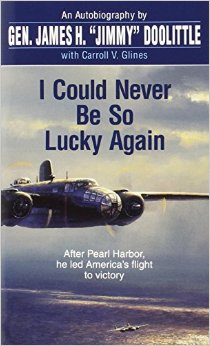 I Could Never Be So Lucky Again is the autobiography of one of the United States’ great heroes: Lieutenant General James (Jimmy) H. Doolittle—aviation pioneer, and Doctor of Science in Aeronautical Engineering from the Massachusetts of Technology. After the First World War, he became one of America’s top racing aviators. He won the Schneider Marine Cup, 1925; Mackay Trophy, 1925; Bendix Trophy, 1931; Thompson Trophy, 1932; and many other aviation awards and honors. In 1932, he set the world’s speed record at 296 miles/hour.
I Could Never Be So Lucky Again is the autobiography of one of the United States’ great heroes: Lieutenant General James (Jimmy) H. Doolittle—aviation pioneer, and Doctor of Science in Aeronautical Engineering from the Massachusetts of Technology. After the First World War, he became one of America’s top racing aviators. He won the Schneider Marine Cup, 1925; Mackay Trophy, 1925; Bendix Trophy, 1931; Thompson Trophy, 1932; and many other aviation awards and honors. In 1932, he set the world’s speed record at 296 miles/hour.
Perhaps Lieutenant Colonel Doolittle is best know for his audacious scheme, precision planning, sterling leadership of the B25 aircraft squadron raid on the Japanese homeland during the grim, early months of World War II. He earned the Medal of Honor—America’s highest military award. President Franklin Roosevelt presented the medal to Doolittle. At end of the War, Lieutenant General Doolittle (a reserve officer) was the Commander of the Army Air Forces Eighth Air Force strategic bomber command—stationed in England. Following the conclusion of the War, he served on numerous Government and civilian aviation type committees and boards. In 1989, President George Herbert Walker Bush awarded Doolittle the Presidential Medal of Freedom. Ronald Reagan promoted Doolittle to a full four-star general. Jimmy Doolittle died on September 27, 1993, at age 96.
Should you have more interest in the famous and important Doolittle Raid on Japan, may I suggest that you read my blog comments posted on 18 April 2015—the 73rd anniversary of this daring and critically important event in World War II. The address is “smartinshelton@wordpress.com/”
I am much impressed with Doolittle’s autobiography—perhaps awed is the more accurate term of this great American aviator. I remember clearly, as a young nipper, the newspaper headlines, radio broadcast, and newsreels announcing the raid—a much needed boost to our flagging morale as the Japanese overran Southeast Asia including the Philippine Islands and threatened Australia.
No need to summarize the contents—read it. Suffice to note that the writing is empathetic as he leads us through the key elements of his life. We garner insight in the real man—a man of honor, daring, and patriotism. My negatives are:
- He (or the publisher) failed to post photographs of the cadre of aircraft he flew, important locations, and of many of the persons with which he interacted.
- There are no maps. Accordingly, it’s difficult to follow his adventures and we loose perspective. The surfeit of maps is a major failing in this otherwise superior tome.